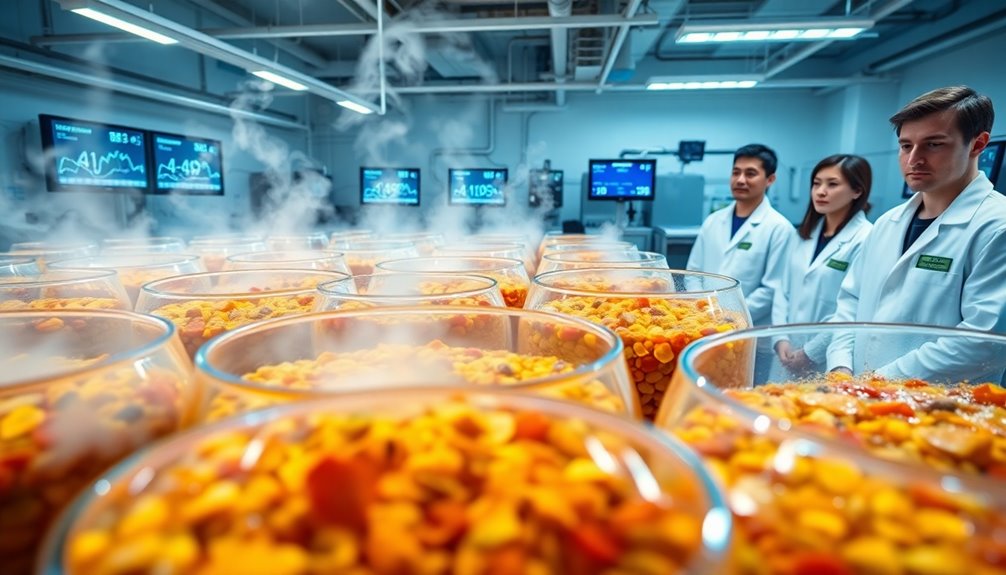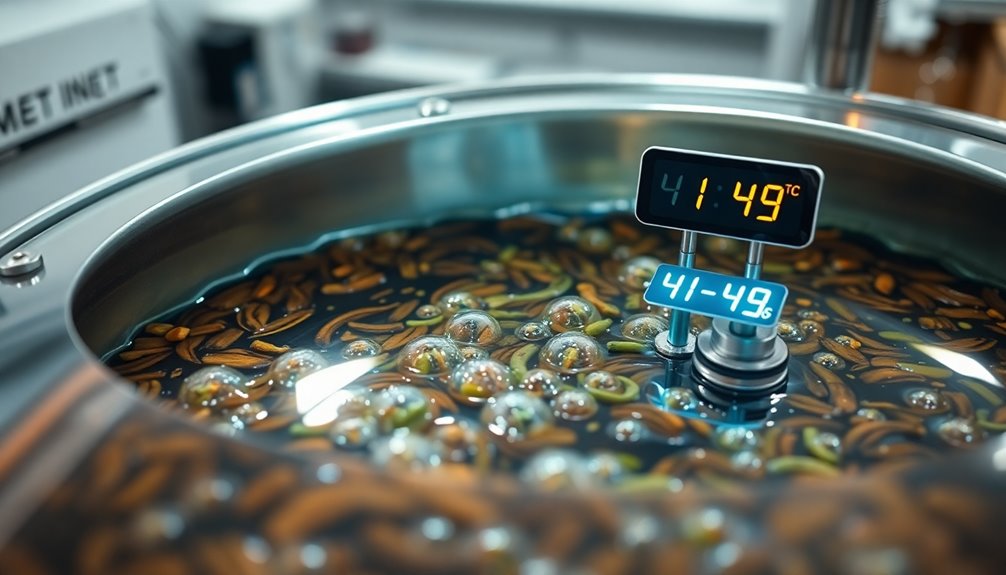Anaerobic digestion at temperatures between 41°C and 49°C significantly boosts methane production and keeps your system stable. Higher temperatures enhance microbial activity and accelerate organic matter breakdown, leading to increased biogas yields. This range also ensures a favorable environment for beneficial methanogens, promoting consistent performance. Additionally, maintaining optimal pH levels during this process is crucial for microbial health. Discovering effective strategies can maximize your renewable energy generation potential.
Key Takeaways
- The optimal temperature range of 41–49°C accelerates the breakdown of organic matter, enhancing methane yields significantly.
- Higher temperatures improve microbial activity, resulting in more efficient methanogenesis and increased biogas production.
- Maintaining temperatures within this range ensures system stability, leading to consistent performance and reliable energy output.
- Elevated temperatures can minimize the accumulation of volatile fatty acids, preventing disruptions in the anaerobic digestion process.
- The combination of optimal temperature and microbial health fosters a balanced environment, maximizing renewable energy generation and sustainability.

Anaerobic digestion is a powerful process that transforms organic waste into valuable energy. As you explore the realm of methane production, you'll find that maintaining optimal temperatures between 41°C and 49°C can significantly enhance methane yields while ensuring system stability. This temperature range supports the methanogenesis phase, where specialized microorganisms convert organic materials into biogas, primarily composed of methane and carbon dioxide.
Operating within this temperature window allows you to optimize the biological processes at play. When you maintain mesophilic conditions around 35°C, you might see decent methane production, but pushing the temperature higher can lead to even greater yields. At 41°C to 49°C, the methanogens become more active, accelerating the breakdown of organic matter. Additionally, anaerobic digesters capture methane from organic waste, transforming it into biogas.
You'll notice that controlling pH levels is also crucial, as a balanced environment fosters the growth of these beneficial microbes.
Co-digestion is another strategy worth considering. By mixing various feedstocks like food waste, sewage sludge, and animal manure, you can enhance methane production while minimizing volatile fatty acid (VFA) accumulation. This balance not only boosts energy output but also helps maintain the stability of the system.
You'll be able to harness the full potential of the feedstocks available to you, maximizing the renewable energy generated through anaerobic digestion.
Furthermore, the environmental benefits of this process are significant. By utilizing methane as a renewable energy source, you can contribute to reducing greenhouse gas emissions. The energy potential from anaerobic digestion is immense, turning what would otherwise be waste into a valuable asset.
As you investigate the advantages of working within the 41°C to 49°C range, you'll see how effective temperature control, combined with co-digestion, can help you achieve optimal methane production while ensuring a stable and efficient anaerobic digestion system.
Frequently Asked Questions
What Types of Feedstock Are Best for 41–49°C Anaerobic Digestion?
For anaerobic digestion at 41–49°C, you'll want to focus on feedstocks like municipal food waste, agricultural manures, and commercial food scraps.
These materials are high in moisture and easily degradable, which helps maximize methane production.
Sewage sludge can also be beneficial, especially when co-digested with other organics.
How Does Temperature Affect Microbial Activity in Anaerobic Digestion?
Temperature plays a crucial role in microbial activity during anaerobic digestion.
As you increase the temperature, microbial metabolism speeds up, enhancing the breakdown of organic matter. However, if it gets too hot or too cold, you can inhibit microbial activity, leading to lower biogas production.
Optimal temperatures, usually between 35°C and 60°C, ensure that the microbial community thrives, maximizing efficiency and stability in the digestion process.
It's all about finding that sweet spot!
What Are the Challenges of Maintaining a Stable Temperature in Digesters?
Imagine trying to keep a delicate soufflé from collapsing; maintaining a stable temperature in digesters is just as challenging.
Fluctuating temperatures can disrupt microbial growth, leading to inconsistent biogas production. If you're not careful, you might face operational issues like foaming.
Plus, managing temperature demands energy and precise control methods, which can strain your budget.
Ultimately, without careful monitoring, the efficiency of your anaerobic digestion process could suffer significantly.
Can Anaerobic Digestion at These Temperatures Reduce Odor Emissions?
Yes, anaerobic digestion at these temperatures can significantly reduce odor emissions.
By breaking down volatile compounds responsible for unpleasant smells, you can improve the overall environment of your facility.
Additionally, the process tends to kill harmful pathogens and weed seeds, further minimizing odors.
With advanced digestion techniques and optimal conditions, you'll enhance solids retention time, which also contributes to effective odor reduction in your waste management systems.
What Is the Impact on Nutrient Recovery From Anaerobic Digestion?
When you consider the impact on nutrient recovery from anaerobic digestion, you'll find it's quite significant.
The process generates digestate, rich in nutrients like nitrogen and phosphorus, which remain available for recovery. By using this nutrient-rich slurry as a fertilizer, you can enhance soil health and reduce reliance on chemical fertilizers.
Advances in recovery technologies further optimize this process, promoting sustainability and improving agricultural practices while minimizing environmental impacts.
Conclusion
In conclusion, embracing anaerobic digestion at 41–49°C not only boosts methane production but also enhances system stability. By optimizing temperature, you unlock greater efficiency and reliability, paving the way for sustainable energy solutions. You gain higher yields and minimize operational risks, creating a win-win scenario for both producers and the environment. So, let's harness this innovative approach, drive progress, and contribute to a greener future together. It's time to dig deeper into the potential of anaerobic digestion!







